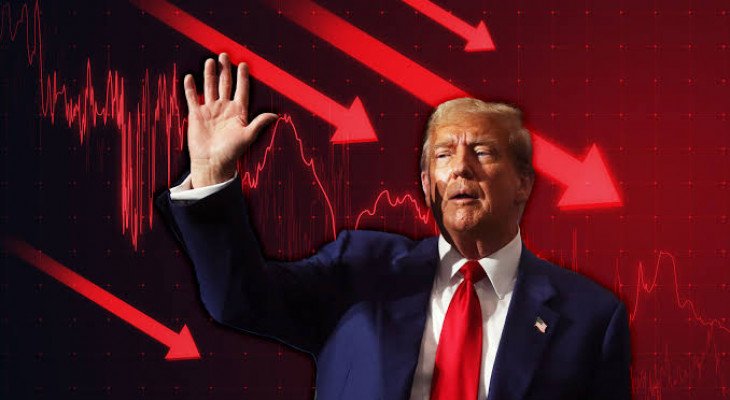For a long time, Indian markets have only encountered the positive aspects of the markets. Nevertheless, markets cannot ascend endlessly, cycles are a fundamental aspect of the financial environment. In euphoric periods, stories, chatter, and speculative tales prevail, strengthening a feeling of complacency.
Despite the Modi government’s measure in providing tax relief to boost consumption and the Indian Central Bank’s or RBI’s 0.25 per cent cut in the repo rate along with other measures to inject liquidity, the stock market continued to suffer a blood bath amid foreign capital outflows. The foreign institutional investors (FIIs) withdrew USD 10 billion from the Indian market in the first 30 days of 2025.
Experts claimed that the whims of US President Donald Trump are lingering uncertainty in the Indian stock market. His recent stunt of imposing a 25 per cent duty on steel and iron imports continued to deliver shocks from his protectionist policy.
“Volatility around tariff policies creates economic uncertainties and, in most cases, depreciates emerging markets currencies. Trade Tariffs are inflationary which can slow down economic growth and the pace of rate cuts. All these factors can dampen investor confidence. Short to medium-term volatilities can be unnerving to the investors,” said Manish Jain, Director, Institutional Business (Equity and FI) Division at Mirae Asset Capital Markets.
Indian equities have seen a vanish of roughly USD 180 billion resulting in a decline of market capitalisation from USD 4.85 trillion to USD 4.67 trillion over the two days since US President Donald Trump revealed plans to impose reciprocal tariffs on multiple nations, with numerous analysts suggesting that the world’s fifth-largest economy may suffer the most.
Past Tariff Schemes
The Smoot-Hawley Act of 1930 was a US law that raised tariffs on 20,000 imported goods to protect American farmers and industries during the Great Depression. It aimed to make foreign products more expensive to encourage domestic consumption in America.
However, instead of reviving the US economy, it triggered a global trade war. Many countries retaliated by imposing their tariffs on American exports, leading to a sharp decline in international trade. Major economies like Canada, Britain, France, and Germany imposed counter-tariffs, worsening the economic downturn worldwide.
A report by DSP Mutual Fund claimed that the act may have contributed to the Great Depression, as global trade collapsed by over 60 per cent between 1929 and 1934. US agricultural and industrial exports suffered, and unemployment surged.
During Trump’s first term, tariffs imposed on almost USD 400 billion in goods resulted in unforeseen effects. A 2019 study by the Federal Reserve discovered that sectors most affected by these trade barriers experienced job losses rather than increases. Manufacturing jobs decreased by roughly 75,000, as increased input expenses and retaliatory tariffs eliminated any advantages of protecting domestic manufacturers.
“Tariff threat does have a significant impact on market volatility. Especially when such proposed policies have a likelihood of impacting the bottom lines of companies, it affects the investor’s confidence. However, this sensitivity is quite evident in the steel and aluminium sectors where India’s exports to the US are high. Globally the equity market is becoming more hyper-sensitive to geopolitical issues, and thanks to the absence of asymmetric information flow,” said Narayani Ramachandran, Director, NMIMS Bengaluru.
In the meantime, the Congressional Budget Office estimated that by 2020, trade restrictions had cut 0.3 per cent from real GDP and lowered the average household income by USD 580.
Gold And Rupee
The current crisis has also injected significant volatility in Gold and Rupee. The yellow metal which touched its low of Rs 67,450 per 10 grams in June 2024, currently trades above Rs 86,000 per 10 grams in February 2025. Gold, also known as ‘safe-haven’ rose Rs 8,356 per 10 grams in the initial six weeks of 2025.
However, a report by DSP Mutual Fund Revealed that among the emerging markets, only the Indian market outperformed the gold returns (in local currency) in the 21st century. However, the depreciating Indian rupee remains a concern.
From October 2022 to the beginning of October 2024, the Indian Rupee depreciated by only 0.6% annually. In fact, for a year and a half, USD Indian rupee barely budged a per cent around the 83 mark, recording one of the most non-volatile periods of the 21st century.
The absence of FDI inflows, large sales by FPIs in equity markets, and a patchy trade balance coincided with a stronger US Dollar. The RBI ended up selling nearly USD 50 billion in the last three months of 2024 to stem the fall in the Rupee.
“The Indian Rupee remains overvalued and prone to weakness if the US Dollar were to strengthen globally. This is one factor that will keep foreign investment flows tentative. The Indian Rupee is a key monitorable for the next few months,” stated the DSP Mutual Fund report.
Indian Threat
Trump’s chief economic advisor stated that India imposes ‘extremely high’ tariffs. Analysts indicated that this puts India at risk of retaliatory US tariffs, with Morgan Stanley and Citi predicting an increase of 4 to 6 percentage points. Since 25 November, when Trump initially warned of tariffs, the Nifty has declined by 4.7 per cent.
To prevent a possible trade war, Modi is readying tariff reductions and is anticipated to suggest raising energy and defence imports before his two-day trip to the U.S. starting Wednesday.
Mid, Small Cap Bloodbath
Following impressive gains in recent years, mid-cap and small-cap stocks faced considerable selling pressure in 2025, prompting many analysts to recommend a transition to large-cap stocks due to the current market decline.
The mid-cap sector has considerably lagged behind the overall market in 2025 to date. The Nifty Midcap index has fallen more than 12 per cent, while the benchmark Nifty index has decreased by 2.5 per cent in the same timeframe.
The sell-off has been notably harsh this month, with the Nifty Midcap index dropping an additional 6 per cent following a 6 per cent decrease in January 2025. Conversely, the Nifty has decreased by 2 per cent in February thus far after falling 0.6 per cent in January.
In the Nifty Midcap 100 index, just 13 stocks have shown positive returns thus far in 2025, whereas the other 87 have experienced losses.
Jain highlighted that the mid and small-cap segment is going through a cyclical phase correction. Since they are high beta, they tend to correct more vis a vis large caps and Nifty. There are some more corrections left in this space.
Crash Ahead?
The last crash of covid in 2020 plunged the market by 38 per cent which took 200 days to recover, while the 2015 sell-off which resulted in a 25 per cent fall took 600 days to recover. Such sharp crashes and prolonged periods of recovery dampen sentiments among the investors who estimate short-term wealth from a volatile market.
Jain cautioned that benchmark indices can see another 5 to 6 per cent cut from here. However, he does not expect 20 per cent or more correction as of now. Although a correction of around 16 to 17 per cent from the peak is expected, that’s where price and PE compression should align, he said.
It is quite important for investors not to book profits and focus on building for the future. It is acid test time and as far as the mid and small cap segments are concerned. The ones that endure this business cycle will emerge as winners, stated Ramachandran.
The Indian stock market is facing turbulence due to US trade policies, foreign capital outflows, and macroeconomic uncertainties, with Trump’s tariffs adding to volatility. While historical downturns suggest recovery, experts warn of further corrections before stabilisation. Despite short-term headwinds, India’s economic fundamentals remain strong, and strategic policy measures could restore stability.







